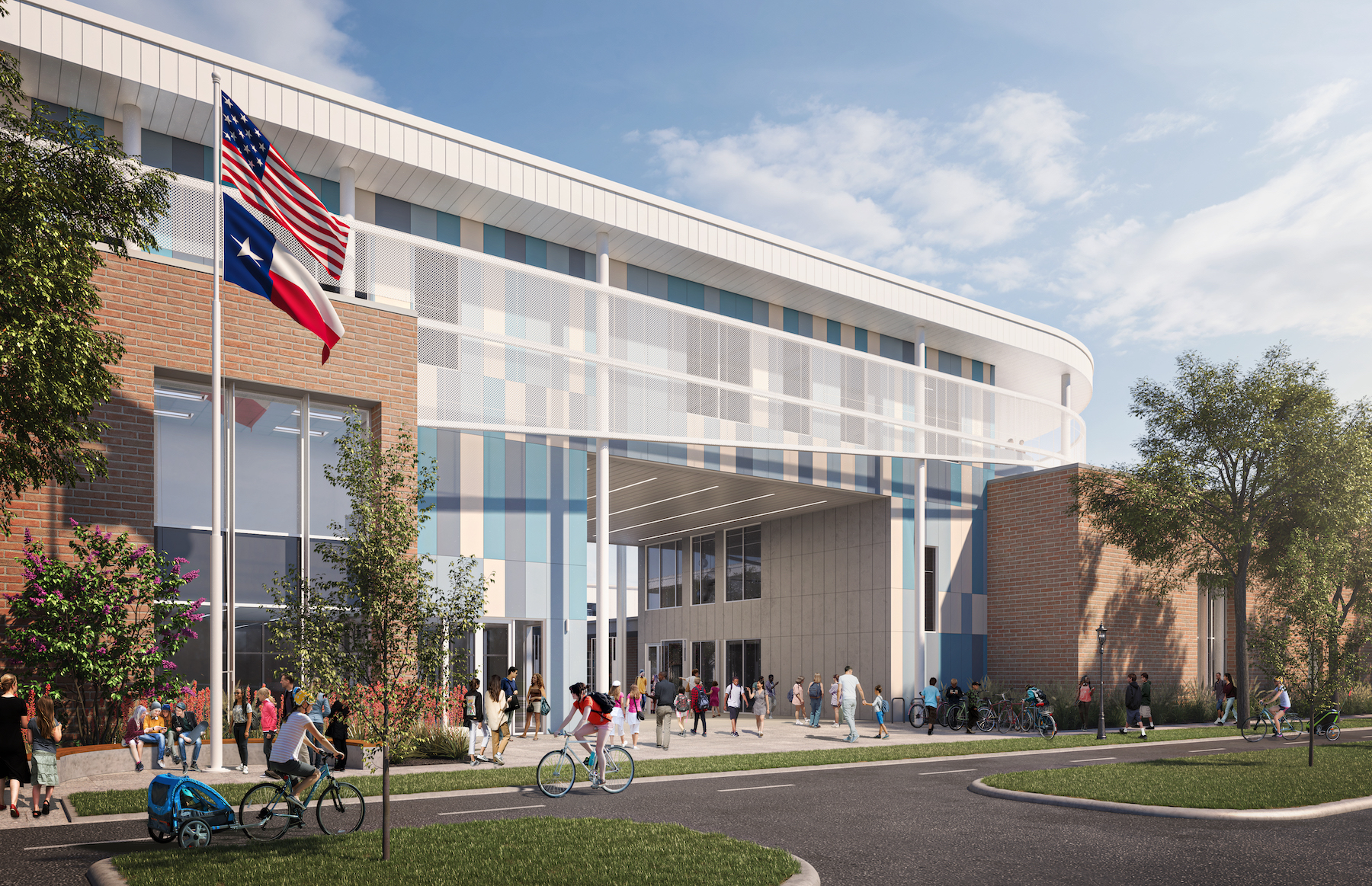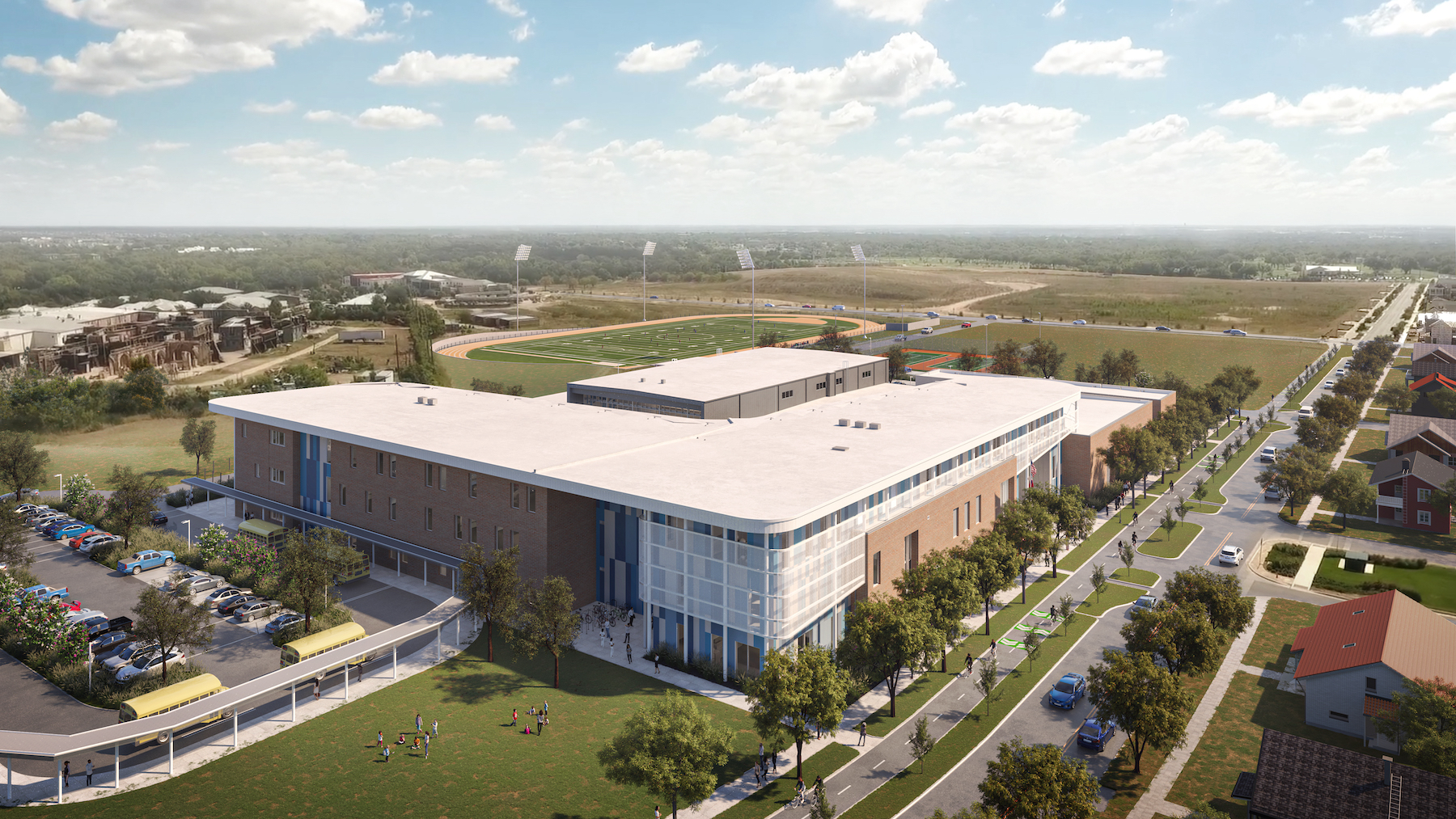Mueller is a 700-acre master-planned community located three miles from Austin, Texas, on what had been the Robert Mueller Municipal Airport that dated back to the late 1920s.
A public-private partnership between the City of Austin’s Economic Development Department and Catellus Development Corporation, Mueller, upon its build out within the next decade, will encompass at least 6,900 homes and apartments, a 42-acre mixed-use town center known as Aldrich Street, 5.5 million sf of commercial space, 750,000 sf of retail space, a medical center, film studio, children’s museum, an 83,000-sf grocery store, and 140 acres of parks and open spaces.
In support of this “new urbanist” environment, the Austin Independent School District—which already owns a performing arts center that opened within Mueller in early 2015—last August started construction on a 130,000-sf Middle School on 10 acres along the northeast section of the city and Mueller, that will double as a hub that links the school to this community’s neighborhoods. The middle school, with an 800-student capacity for 6th through 8th graders, is expected to be ready to accept students and teachers in August 2023.
The new middle school “will contribute to the fabric of the community,” predicts Kate Mraw, ALEP, RID, LEED AP BD+C, principal and design director for LPA, the architect on this project. The school will connect to Mueller’s bike and hiking trails, and offer a park and other public spaces on its premises. And because it will draw students from beyond the immediate neighborhood, it will bring greater diversity into the community.
A QUICKER WAY TO BUILD SCHOOLS
LPA and Coleman Landscape Architects are working with Joeris General Contractors, which the Austin ISD hired to spearhead this design-build project.
Burton Hackney, Vice President of Central Texas for Joeris General Contractors, tells BD+C that while the design-build delivery method is still the exception for building schools in the Lone Star State, “after the bond passed, [the district] needed a way to get some schools up quickly.” The Mueller project is one of 19 new constructions and modernizations that the Austin ISD is engaged in, funded by a $1 billion bond that voters passed in late 2017.
Hackney, an Austin native, says the airport redevelopment has long been thought of locally as “sacred space.” At one time, a new elementary school was on the table. But, he recalls, the district’s circumstances changed: at the time the bond was floated, more than 1,000 middle school students had been leaving the region from nearby charter schools, according to the ISD’s Facility Master Plan.
This is Joeris’ second design-build project for the district. Hackney says his firm’s culture “aligns” with that delivery method because it emphasizes lean principles. “We didn’t have to go through the value-engineering process because the GC was involved in all the meetings right from the start,” confirms Mraw.
DEMOCRATIC DESIGN

The Building Team is pretty much working from the ISD’s design documents. But the design process also included “a diverse stakeholder group that was heard from,” says Hackney. Catellus had a representative on the architecture team. And Mueller “was very specific about what it wanted,” he states.
During the design phase for the middle school, there were 16 architectural team meetings, four community meetings, and seven neighborhood meetings. The Austin ISD initiated those early talks, which Mraw says focused on “hopes, goals, and dreams,” as well as the importance of sustainability.
Mueller was the first neighborhood in Texas to earn LEED for Neighborhood Development Stage 3 Gold Certification. All the roofs of the Austin ISD Middle School will be solar ready. Durable and environmentally friendly materials are being used throughout, and 100 percent recycled water will irrigate the site’s vegetation. The school’s design—which takes into account its orientation to the sun—is expected to reduce energy use by 32 percent from a baseline standard.
The school design also pays homage to the original Mueller airport with a large, wing-shaped roof, a gymnasium that resembles an aircraft hangar, and runway-inspired wayfinding graphics throughout the campus.
A NOD TO THE PAST

Hackney says there was budgetary discussion, during the design phase, about what kinds of materials to use for the school’s exterior skin to resemble the Art Deco-like pattern of the eight-story airport tower, which is still standing. (The tower’s dark and light blue panels were restored several years ago.) The agreed-upon material is an integral-colored fiber cement panel made by the manufacturer TAKTL.
According to LPA, other exterior building materials are being used, too, including brick masonry veneer, a perforated and corrugated white metal screen, and anodized aluminum for the metal soffit and roof fascia panels.
The school’s roof and stacking also went through some changes to address budgetary concerns. The project’s total cost is $53.2 million, of which $45.5 million is for construction.
Related Stories
| Aug 11, 2010
Great Solutions: Green Building
27. Next-Generation Green Roofs Sprout up in New York New York is not particularly known for its green roofs, but two recent projects may put the Big Apple on the map. In spring 2010, the Lincoln Center for the Performing Arts will debut one of the nation's first fully walkable green roofs. Located across from the Juilliard School in Lincoln Center's North Plaza, Illumination Lawn will consist ...
| Aug 11, 2010
Dream Fields, Lone Star Style
How important are athletic programs to U.S. school districts? Here's one leading indicator: In 2005, the National Football League sold 17 million tickets. That same year, America's high schools sold an estimated 225 million tickets to football games, according to the American Football Coaches Association.
| Aug 11, 2010
Back to Nature: Can wood construction create healthier, more productive learning environments?
Can the use of wood in school construction create healthier, safer, more productive learning environments? In Japan, there's an ongoing effort by government officials to construct school buildings with wood materials and finishes—everything from floors and ceilings to furniture and structural elements—in the belief that wood environments have a positive impact on students.
| Aug 11, 2010
High School in a Hurry
One of the more compelling arguments for charter schools is their theoretical ability to streamline decision making. Eliminate all those layers of bureaucratic fat that clog the arteries of most public school systems, the argument goes, and decisions can be made to flow much more smoothly, even when it comes to designing and building a major school project.
| Aug 11, 2010
Bronze Award: Garfield High School, Seattle, Wash.
Renovations to Seattle's historic Garfield High School focused mainly on restoring the 85-year-old building's faded beauty and creating a more usable and modern interior. The 243,000-sf school (whose alumni include the impresario Quincy Jones) was so functionally inadequate that officials briefly considered razing it.
| Aug 11, 2010
Managing the K-12 Portfolio
In 1995, the city of New Haven, Conn., launched a program to build five new schools and renovate and upgrade seven others. At the time, city officials could not have envisioned their program morphing into a 17-year, 44-school, $1.5 billion project to completely overhaul its entire portfolio of K-12 facilities for nearly 23,000 students.
| Aug 11, 2010
Financial Wizardry Builds a Community
At 69 square miles, Vineland is New Jersey's largest city, at least in geographic area, and it has a rich history. It was established in 1861 as a planned community (well before there were such things) by the utopian Charles Landis. It was in Vineland that Dr. Thomas Welch found a way to preserve grape juice without fermenting it, creating a wine substitute for church use (the town was dry).
| Aug 11, 2010
School Project Offers Lessons in Construction Realities
Imagine this scenario: You're planning a $32.9 million project involving 112,000 sf of new construction and renovation work, and your job site is an active 32-acre junior-K-to-12 school campus bordered by well-heeled neighbors who are extremely concerned about construction noise and traffic. Add to that the fact that within 30 days of groundbreaking, the general contractor gets canned.
| Aug 11, 2010
High Tech High International used to be a military facility
High Tech High International, reconstructed inside a 1952 Navy metal foundry training facility, incorporates the very latest in teaching technology with a centerpiece classroom known as the UN Theater, which is modeled after the UN chambers in New York. The interior space, which looks more like a hip advertising studio than a public high school, provides informal, flexible seating areas, abunda...
| Aug 11, 2010
High-Performance Modular Classrooms Hit the Market
Over a five-day stretch last December, students at the Carroll School in Lincoln, Mass., witnessed the installation of a modular classroom building like no other. The new 950-sf structure, which will serve as the school's tutoring offices for the next few years, is loaded with sustainable features like sun-tunnel skylights, doubled-insulated low-e glazing, a cool roof, light shelves, bamboo tri...







